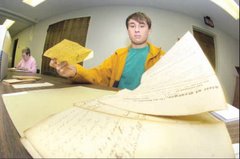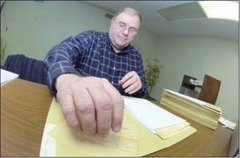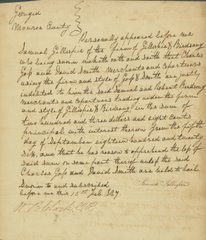August 1, 2007 – January 31, 2008
Objectives:
a) flattening and scanning 53 linear feet of Troup County court records
b) Converting the Guide to Troup County Records to EAD and using automated scripts to create folder level records
c) Linking the scanned images to the folder level EAD records
d) Creating microfilm of the scanned images for long-term preservation
e) Testing the usability of the digitized materials with at least two focus groups and reporting on the results of the tests
f) Developing tracking methods to explore use of the digitized collection and compiling annual reports for at least three years after completion of the project
g) Developing a website that publicizes the project and describes the processes used at both the Troup County Archives and the Digital Library of Georgia
h) Publicize the project and its methods through press releases, announcements on appropriate listserves, articles in at least two publications, and presentation of the project during at least one professional conference.
Summary of Project Activities
The Troup County Scanning Project is proceeding according to plan. During this period, 10.5 linear feet of materials were scanned. As of January 31, 19 years of 19th century court records have been scanned in accordance with guidelines prepared by staff of the Digital Library of Georgia. Work has begun to convert the 1986 finding aid to Troup County court records to EAD. A second scanner was purchased so that scanning could take place during more of the Troup County Archives’ working hours.
Other activities have included hiring a second staff member to work at the Troup County Archives to scan the documents. The Troup County Archives staff has worked with the Digital Library staff to name and number image files to match the finding aids. Additionally a blog created to chronicle progress of the project has been updated periodically.
Accomplishments
a) Flattening and Scanning: Eleven people volunteered to assist in flattening the documents and prepare them for scanning. A total of 553 volunteer and staff hours were spent completing the project. Flattening was completed during the spring of 2007.
In mid-May, staff began scanning the flattened documents. During the first period of the grant, three linear feet were scanned. By January 2008, an additional 10.5 linear feet of materials have been scanned. Scanning continues to proceed slowly, though the pace has picked up considerably since the first months. Our two scanners work part-time, averaging 25 to 30 hours per week. We will try to have at least one additional person and perhaps one volunteer to work on the scanning project when the regular staff members are off duty. At this point, one-fourth of the records have been scanned – both in number of years to be covered and in size of records to be scanned. Fortunately, only one-fourth of the NHPRC monies for salaries and wages have been expended as well.
b) EAD Conversion
A consultant who works with the Digital Library of Georgia as her full-time job (Sheila McAllister) has begun the EAD conversion of the 1986 finding aid. She directed Archives staff on how to name the individual scans and documents. She did the sample page for the grant application and has begun working on the EAD conversion. EAD conversion is expected to be completed during the spring.
.
c) Linking scanned images to EAD
In May, during the previous grant-reporting period, the project director plus one of the scanners (this person has been on the scanning project since the earliest days of scanning) traveled to Athens, Georgia, and trained with the Digital Library staff. On that day, file names were established and have been consistently used so that the scanned images should link to the EAD finding aid once it is completed.
d, e, f) Creating microfilm, testing the usability of the digitized materials, developing tracking methods to explore use of the digitized collection and compiling annual reports will all be done in the coming months and have not yet been started.
g) Developing a website that publicizes the project and describes the processes used at both the Troup County Archives and the Digital Library of Georgia has begun and has been used to describe the flattening project. A blog has been created and has several articles on it. http://troupscanning.blogspot.com/ The blog needs to be updated with information about the actual time required for the flattening and with details about the scanning and EAD conversion. These articles will be added in the coming months. Also, more effort will be made to publicize the existence of the blog.
h) Publicize the project
The LaGrange Daily News has included two articles about the grant, including one top of the fold, at the beginning of the project. Additionally, the Troup County Historical Society newsletter has included articles. The project has been mentioned in the newsletter of the Association of County Managers and in an article in the Atlanta Journal Constitution about the IMLS “Preserving America” conference. An article in Annotations about the project is forthcoming. In future months, efforts will be made to have additional articles in the LaGrange, Atlanta, Columbus, and West Point newspapers plus in newsletters and journals of professional publications. Project Director Kaye Minchew will be one of the speakers in a panel discussion about digitizing collections in the 2008 Annual meeting of the Society of American Archivists.
4. Assessment
The original goals of this project generally appear to have been somewhat overly optimistic, though we expect to meet all of our goals, perhaps with an extension of time. Everyone involves remains excited about the project and we are looking forward to researchers from various parts of the US and the world being able to use the documents via the Internet.
We also remain excited about this scanning project being a model for other scanning projects. We firmly believe that creating minimal metadata and spending minimal time processing the collection is an excellent way to do archival scanning projects. We are trying to follow this example in more of our processing projects at the Troup County Archives with both manuscript collections and with government records. Specifically, sometime in the next twelve months, we expect to significantly update and revise the Troup County Archives’ website (www.trouparchives.org). With the new website, we plan to include for the first time lists of government records and be ready to insert scanned pages as they become available. For instance, over time, we should be able to scan pages of Troup Inferior Court minutes. The Inferior Court heard both misdemeanor cases and acted as county commissioners in the early decades of Troup County’s existence. We could scan these pages and include only the briefest of descriptions about the minute books. We expect to do similar processing of manuscript collections and hope to include scanned images of some of our most popular collections. For example, we have a finding aid for the Julius Schaub collection. We appreciate Schaub’s excellent photographs made between 1881 and his death in 1910 and use them frequently. Many of our researchers get more excited about a company history he wrote of the NC Confederate military unit that he served in. Putting up scanning of his handwritten company history could help make this part of the collection much more accessible.
One major item has not gone according to expectation should have been expected: scanning individual documents takes much longer than expected. Scanning to the standards set by the Digital Library of Georgia is time consuming. To speed up scanning, we would need to scan at 100 dpi but the lower dpi would not produce the quality of scans that DLG or the Troup County Archives would like to produce. We have consulted with Toby Graham, head of the Digital Library about increasing the speed of the project and are in agreement that the quality of the product is the most important part of this project.
5. Costs
Estimated costs:
As stated in our interim report filed in August 2007: Flattening the documents: 350 hours at $9.00 = $3150 (these hours were donated by volunteers) plus 200 hours by TCA staff at $19 per hour = $3800. A total of 550 hours and an equivalent of $6950. went into flattening and document preparation. (Staff time was spent supervising volunteers, reboxing, reshelving, preparing new shelf list, labeling boxes, etc.) Average cost per linear foot to flatten and prep $131.25 per linear foot.
(Note: $9.00 per hour was chosen because some of the volunteers had extensive professional experience in working with technology while others had no experience.)
Converting paper copy of finding aid to word file 50 hours at $33.00 per hour = $1650 (volunteer hours donated by the Project Director, work done on her own time.)
Scanning – basic cost has averaged $8.50 per hour. Additional costs include the scanner, computer and overhead. In the first reporting period, 232 hours were spent scanning about 3 linear feet. Salary costs were $1906. In August, 2007, we projected that it would take 3850 hours to finish the project.
As of January 2008, 1162 total hours have been spent on this project – 930 hours during this reporting time. The salary costs for this period are $8321. During this period, scanning a linear foot of records took approximately 88 hours to complete. This seems very high but one needs to remember that these are 19th century documents. Individual pages of a file are often different sizes and pages are often attached with glue or a wax seal that cannot be removed. Care has to be taken to not damage the documents.
Our goal in August 2007 was to spend up the process and get more scanning done more quickly. The cost per page averaged 33 cents. We have not yet been able to get this number down. The cost per linear foot is about $898. This is above the accepted range according to Harvard University’s website, using May 2006 figures (accepted is $150 to $750 per linear foot box) and these records are old and varying sizes. Nonetheless, we will be working to speed the process along. We will be looking for other ways to speed the process but our options may be limited. At this point, our employees working on the scanning project has stabilized and that may be our best way to improve scanning time. One person worked on the project for about a month was very very slow in picking up the process. Also, training new people on the scanning takes time. Having the same people on the scanning project should speed the process up. We have consulted with Toby Graham of the Digital Library of Georgia but have agreed that the only way to really speed up the process is to change our scanning specifications – to perhaps 100 dpi rather than 300 dpi and scan as a personal or home project rather than in professional mode, but we all agree that we are unwilling to lessen our quality standards.
Metadata creation – unable to give an estimate at this point.
6. Impact
The impact of the project on the grant-receiving institutions, especially on the Troup County Historical Society, has already been significant. Staff at the Archives continues to reconsider processing methods of larger collections and may begin scanning of collections, especially if we can minimize the time-consuming creation of metadata. Impacts beyond these two points will come in future months and years after the scans of court records are placed on the Internet.
Monday, June 23, 2008
Subscribe to:
Post Comments (Atom)





6 comments:
Hi! Do you know if they make any plugins to safeguard against hackers?
I'm kinda paranoid about losing everything I've worked hard on.
Any tips?
Feel free to surf to my homepage ... raspberry ketone review
Every weekend i used to visit this website, because
i wish for enjoyment, as this this site conations actually
fastidious funny material too.
Feel free to visit my web page: Slim Lipo Plus
Sweet blog! I found it while browsing on Yahoo News. Do you have any suggestions on how to get listed in Yahoo News?
I've been trying for a while but I never seem to get there! Thank you
Feel free to surf to my webpage :: garcinia cambogia
great submit, very informative. I'm wondering why the opposite specialists of this sector don't notice this.
You must proceed your writing. I'm sure, you've a great readers' base already!
my website - No2 maximus facts
Hello! I just wanted to ask if you ever have any issues with hackers?
My last blog (wordpress) was hacked and I ended up losing
several weeks of hard work due to no data backup. Do you have any solutions to
stop hackers?
123 income academy reviews
Thanks for the marvelous posting! I actually enjoyed reading it, you are a
great author. I will remember to bookmark your blog and may come back in the foreseeable future.
I want to encourage you to continue your great job, have a nice evening!
Green coffee
Post a Comment